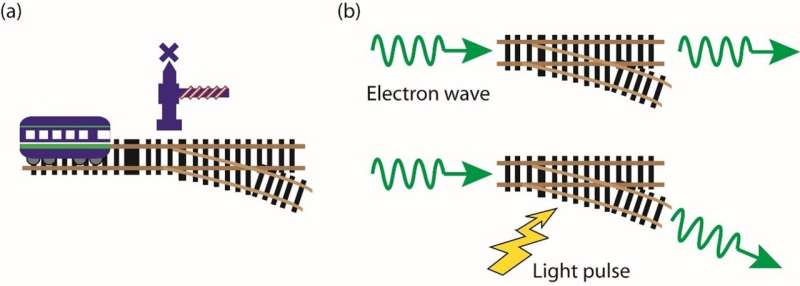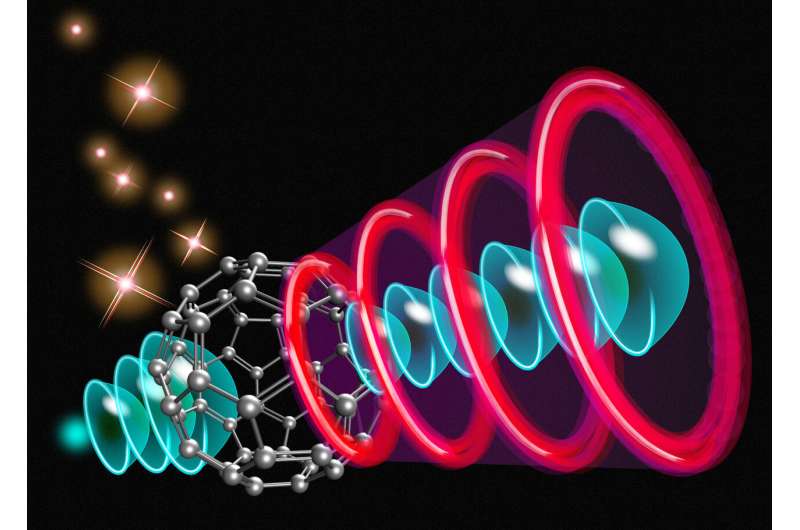This article has been reviewed according to Science X's editorial process and policies. Editors have highlighted the following attributes while ensuring the content's credibility:
fact-checked
peer-reviewed publication
trusted source
proofread
A special carbon molecule can function as multiple high-speed switches at once

For the first time, an international team of researchers, including those from the University of Tokyo's Institute for Solid State Physics, has demonstrated a switch, analogous to a transistor, made from a single molecule called fullerene.
By using a carefully tuned laser pulse, the researchers are able to use fullerene to switch the path of an incoming electron in a predictable way. This switching process can be three to six orders of magnitude faster than switches in microchips, depending on the laser pulses used. Fullerene switches in a network could produce a computer beyond what is possible with electronic transistors, and they could also lead to unprecedented levels of resolution in microscopic imaging devices.
More than 70 years ago, physicists discovered that molecules emit electrons in the presence of electric fields, and later on, in certain wavelengths of light. The electron emissions created patterns that enticed curiosity but eluded explanation. This has changed thanks to a new theoretical analysis, the ramification of which could not only lead to new high-tech applications, but also improve our ability to scrutinize the physical world itself.
Project Researcher Hirofumi Yanagisawa and his team theorized how the emission of electrons from excited molecules of fullerene should behave when exposed to specific kinds of laser light, and when testing their predictions, they found they were correct.

"What we've managed to do here is control the way a molecule directs the path of an incoming electron using a very short pulse of red laser light," said Yanagisawa. "Depending on the pulse of light, the electron can either remain on its default course or be redirected in a predictable way. So, it's a little like the switching points on a train track, or an electronic transistor, only much faster.
"We think we can achieve a switching speed 1 million times faster than a classical transistor. And this could translate to real world performance in computing. But equally important is that if we can tune the laser to coax the fullerene molecule to switch in multiple ways at the same time, it could be like having multiple microscopic transistors in a single molecule. That could increase the complexity of a system without increasing its physical size."
The fullerene molecule underlying the switch is related to the perhaps slightly more famous carbon nanotube, though instead of a tube, fullerene is a sphere of carbon atoms. When placed on a metal point—essentially the end of a pin—the fullerenes orientate a certain way so they will direct electrons predictably. Fast laser pulses on the scale of femtoseconds, quadrillionths of a second, or even attoseconds, quintillionths of a second, are focused on the fullerene molecules to trigger the emission of electrons. This is the first time laser light has been used to control the emission of electrons from a molecule in this way.
"This technique is similar to the way a photoelectron emission microscope produces images," said Yanagisawa. "However, those can achieve resolutions at best around 10 nanometers, or ten-billionths of a meter. Our fullerene switch enhances this and allows for resolutions of around 300 picometers, or three-hundred-trillionths of a meter."
In principle, as multiple ultrafast electron switches can be combined into a single molecule, it would only take a small network of fullerene switches to perform computational tasks potentially much faster than conventional microchips. But there are several hurdles to overcome, such as how to miniaturize the laser component, which would be essential to create this new kind of integrated circuit. So, it may still be many years before we see a fullerene switch-based smartphone.
More information: Hirofumi Yanagisawa et al, Light-induced subnanometric modulation of a single-molecule electron source, Physical Review Letters (2023). journals.aps.org/prl/abstract/ … ysRevLett.130.106204
Journal information: Physical Review Letters
Provided by University of Tokyo



















